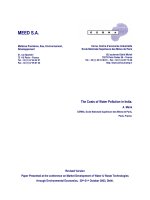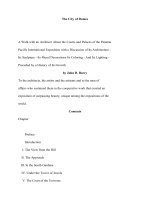Measuring the salinity of water pot
Bạn đang xem bản rút gọn của tài liệu. Xem và tải ngay bản đầy đủ của tài liệu tại đây (73.7 KB, 3 trang )
Measuring the salinity of water
Helen Anderson (Hamilton) and David Cummings (Melbourne)
Novmeber, 1999
LC0064
ISSN 1323-1693
© State of Victoria, Department of Sustainability and Environment Page 1
This Landcare Note is to guide the collection of water
samples and recording their salinity levels.
Salinity measurement
There are two main methods of determining the salt
content of water: Total Dissolved Salts (or Solids) and
Electrical Conductivity.
Total Dissolved Salts (TDS) is measured by evaporating a
known volume of water to dryness, then weighing the solid
residue remaining. Electrical conductivity (EC) is
measured by passing an electric current between two metal
plates (electrodes) in the water sample and measuring how
readily current flows (ie conducted) between the plates.
The more dissolved salt in the water, the stronger the
current flow and the higher the EC. Measurements of EC
can be used to give an estimate of TDS.
Measurement of TDS is tedious and cannot be carried out
in the field. EC measurement is much quicker and simpler
and is very useful for field measurement. There are
however a few simple precautions to note in doing so and
these are outlined here.
Salinity units
TDS is recorded in milligrams of dissolved solid in one
litre of water (mg/L). Parts per million (ppm) is equivalent
to mg/L but it is not a favoured unit.
EC measures the charge carrying ability (ie conductance)
of liquid in a measuring cell of specific dimensions. It is
necessary to clearly define the units of both conductance
and length when talking ECs. To say a water sample is
2000 EC, is like saying a table is 2000 long, without
specifying millimetres, centimetres or metres. The
standard EC unit used by the Victorian Salinity Program
and the Murray Darling Basin Commission is
microSiemens per centimetre (µS/cm) at 25
o
C.
You will however see other units and need to be aware of
the relationships between them. µS/cm relates to other
units as follows:
1000 µS/cm = 1 deciSiemen/metre (dS/m)
1000 µS/cm = 1 milliSiemen/centimetre (mS/cm)
10 µS/cm = 1 milliSiemen/metre (mS/m)
Relationship of total dissolved salts to
EC
EC can be effectively converted to TDS for natural
Victorian waters by the following relationship:
TDS (mg/L) = EC (µ
µµ
µS/cm at 25
o
C) x 0.6
Collecting your water sample
• Make sure that your collecting container is very clean.
Previous contents could affect your result. Use a
container with an opening large enough to take the EC
meter. Do not use jars which smell (eg.vegemite,
pickle jars) if samples are to be kept for a while.
• Choose a sample which is representative of the body
of water being considered. It needs to be a sample
which is like most of the water you want to get
information about. If you don't collect a
representative sample you're wasting your time. Try
not to take your sample too close to the surface,
bottom or sides of the waterbody.
° Flowing Water - For rivers and creeks try to
take your sample in a place where the water if
flowing. Sample well below any stream
junction (a rule-of-thumb is the equivalent of
10 stream widths downstream) to allow good
mixing.
° Still Water - eg. Dams, swamps and lakes.
Saline water is denser than fresh water. This
means, that in a still water body, the saline water
will settle to the bottom. If you have an offtake
pipe from the base of the dam, sample water
from here.
° Groundwater - Stock bores can be tested at the
trough. However, the water should be freshly
pumped. The salinity of water sitting in an
unused trough may be higher than the actual
groundwater salinity level due to concentration
of the salts through evaporation. Investigation
bores may be tested using a bailer to collect a
water sample. Make sure you ask the
permission of the individual or department
responsible for the bore.
• Rinse the container two or three times with some of
the water to be sampled.
• Collect the sample.
Taking your salinity reading
• Ensure your EC meter has been calibrated (see notes
below).
• Remove the protective cap, switch the meter on and
insert the probe into the water sample up to the
immersion level.
• Move the probe up and down to remove bubbles from
around the electrodes.
© State of Victoria, Department of Sustainability and Environment Page 2
Measuring the salinity of water
LC0064
• This will ensure good contact is achieved between
water and electrodes (do not swirl it around as this
may actually drive water out of the probe).
• Allow the probe to reach the temperature of the water
before taking a reading.
• Temperature has a significant impact on the salinity
reading. EC units are standardised to a temperature of
25
o
C. Some meters automatically correct the reading
taken at water temperature to a reading at 25
o
C.
• If the meter has automatic temperature compensation,
wait about 30 seconds before taking your reading if
the water and probe are about the same temperature.
If the water is much colder than the probe, allow a
longer period, say two minutes before taking a
reading.
• If the meter has no temperature compensation take the
temperature of the sample and use a correction table to
get the right value.
• Read the display, and record the result as mentioned
below.
• Rinse the probe with tank water and drain off any
excess water, between each sample and at the end of
sampling for the day. This will prevent false readings
due to salt residues on the meter from the last sample.
Recording your results
The results of any sampling, should be recorded in a
notebook for future reference. The information should
include:
• Name of collector
• Date of sampling Salinity levels fluctuate
throughout the year. The date of sampling becomes
important then when comparing readings.
• Sampling location. Make a note of where the
sample was taken from. Further samples may then be
taken from the same site in the future.
• Water source Make a note of the water source. eg.
River, Creek, Lake, Dam, Swamp, Drain,
Groundwater Bore, etc.
• EC reading. Readings should all be recorded as
microSiemens per centimetre (µS/cm). See Salinty
units (page 1) to convert readings in other units to
µS/cm.
• Temperature reading. If the meter has no
automatic compensation, record temperature and
adjust resulting EC value from a calibration table.
Calibration
EC meters should be calibrated regularly to ensure they are
reading accurately.
The best idea is to calibrate your meter before each
sampling session.
You will need :
Bottle of Calibration Solution:
Bottle of Check Solution
Clean measuring bottle with a lid and opening large
enough to take the EC meter probe.
• Select a calibration solution about midway within the
range of readings you are likely to record.
• Rinse measuring bottle with calibration solution.
(Discard the solution).
Pour 100 ml of the Calibration solution into the
measuring bottle.
• Put the EC meter into the solution, allowing time for it
to adjust for temperature.
• Using a small screw driver or the calibration tool
provided, turn the screw until the display reads the
same as the known salinity of the calibration solution.
• Discard calibration solution. DO NOT pour the
remaining solution back into the original bottle, as this
will contaminate your calibration solution.
• Use the check solution to test the accuracy of the
calibration.
• An unopened bottle of calibration solution has a shelf
life of about two years.
Care of your meter
Rinse the probes with tank water after you have finished
testing to prevent salt build up.
To improve performance, clean the stainless steel
electrodes periodically by rinsing in pure alcohol (eg.
methylated spirits) for 10 to 15 minutes.
Variations in readings or a faint display can indicate
battery failure. Replace the batteries.
A note on accuracy
Pocket Salinity Meters such as the TDScan 4 and the DiST
4 when properly calibrated have a resolution of 100 µS/cm
(i.e. they read to the closest 100 µS/cm). However, if
samples are not collected properly or the meter has not
been calibrated, large errors can occur.
Groups undertaking a salinity monitoring program
comparing readings from site to site and from year to year,
should use a meter with a resolution of at least 10 µS/cm.
Further reading
Chaffey, B., ed., (1992). Principles of Sustainable
Agriculture - Dryland Salinity. Department of
Agriculture, Victoria.
Victorian Irrigation Research and Advisory Services
Committee, (1980). Quality Aspects of Farm
Water Supplies, 2nd edn. Government Printers,
Melbourne.
© State of Victoria, Department of Sustainability and Environment Page 3
Measuring the salinity of water
LC0064
Water quality guidelines
EC range (µ
µµ
µS/cm)
Usefulness of water
0 - 800
• Good drinking water for humans (provided there is no organic pollution and not too much suspended clay material)
• Generally good for irrigation, though above 300 µS/cm, some care must be taken, particularly with overhead
sprinklers which may cause leaf scorch on some salt sensitive plants.
• Suitable for all livestock
800 - 2,500 • Can be consumed by humans although most would prefer water in the lower half of this range if available.
• When used for irrigation, requires special management including suitable soils, good drainage and consideration of
salt tolerance of plants.
• Suitable for all livestock.
2,500 - 10,000
• Not recommended for human consumption, although water up to 3000 µS/cm could be drunk if nothing else was
available.
• Not normally suitable for irrigation, though water up to 6000 µS/cm can be used on very salt tolerant crops with
special management techniques. Over 6000 µS/cm, occasional emergency irrigation may be possible with care, or if
sufficient low salinity water is available, this could be mixed with the high salinity water to obtain an acceptable
supply.
• When used for drinking water by poultry and pigs, the salinity should be limited to about 6000 µS/cm. Most other
stock can use water up to 10,000 µS/cm.
• Water over 4000 µS/cm can cause shell cracking in laying hens.
• High magnesium levels can cause stock health problems in this range. Analysis recommended.
Over 10,000 • Not suitable for human consumption or irrigation
• Not suitable for pigs, poultry or any lactating animals. Beef cattle can use water up to 17,000 µS/cm and adult dry
sheep can tolerate 23,000 µS/cm. However it is possible that waters below these EC levels could contain
unacceptable concentrations of particular ions. Detailed chemical analysis should therefore be considered before
using high salinity water for stock.
• Water up to 50,000 µS/cm (the salinity of the sea), can be used to flush toilets provided corrosion in the cistern can
be controlled.
This publication may be of assistance to you but the State of Victoria and its officers do not guarantee that the publication is without flaw of any
kind or is wholly appropriate for your particular purposes and therefore disclaims all liability for any error, loss or other consequence which may
arise from you relying on any information in this publication.









